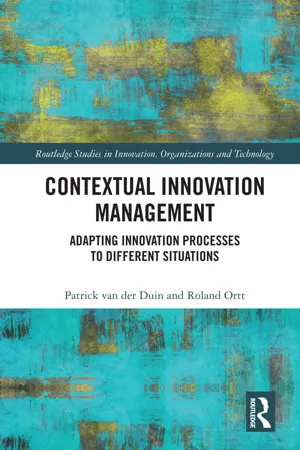Business
Contingency Theory
Contingency theory in business suggests that there is no one-size-fits-all approach to management. Instead, it emphasizes that the most effective way to manage an organization depends on various situational factors, such as the environment, technology, and culture. This theory advocates for adapting management practices to fit the specific circumstances of a given situation.
Written by Perlego with AI-assistance
Related key terms
7 Key excerpts on "Contingency Theory"
- eBook - ePub
Contextual Innovation Management
Adapting Innovation Processes to Different Situations
- Patrick van der Duin, Roland Ortt(Authors)
- 2020(Publication Date)
- Routledge(Publisher)
3 From Contingency to Contextual The faith in success factors is persistent and widespread. In contrast, contingency-theory is a field in management science that adopts the premise that companies should adapt their organization and strategy to the environment or the context. Contingency Theory refutes the idea of a generic and fixed set of success factors. The fact that the environment changes means that companies have to change too. In the natural sciences, changes can be explained using a fixed and generally valid set of equations. In the social sciences, to which management science belongs, change means that different variables and different relationships between them become important, and hence the set of equations to explain the phenomena of change are themselves changing. The contingency perspective is a very relevant perspective to explore and develop specific innovation management approaches that fit particular companies and their environment. 3.1 Introduction: Contingency Theory The notion that business success in general and innovation success in particular can be explained by a general and fixed set of success factors is widely held. In this book, we argue that it is better to consider the way that organizations innovate as context dependent. This notion is theoretically and scientifically rooted in a management theory known as ‘Contingency Theory’. As is the case with many scientific theories, it is not always clear who developed the first ideas and hence can be called the grandfather or grandmother. A classical reference is the work of Paul R. Lawrence and Jay W. Lorsch who with their 1967 book ‘Organization and environment’ hoped to “renew interest in Contingency Theory” (Lawrence and Lorsch, 1967, p. xii). They refer to scientists such as T. Burns and G.M. Stalker (see section 3.5) and others (including the famous management scientist Alfred Chandler) who have laid down the foundation of Contingency Theory - eBook - ePub
Public Relations Theory
Capabilities and Competencies
- Jae-Hwa Shin, Robert L. Heath(Authors)
- 2020(Publication Date)
- Wiley-Blackwell(Publisher)
4 Contingency Theory : Strategic Conflict ManagementIntroduction
The Contingency Theory of conflict management explains the dynamics of public relations practice as choosing the stance that best serves the interests of an organization, while at the same time following strategies that are dependent on the given situation—one that is often unfolding or in flux. This theoretical perspective suggests that public relations professionals adopt an “it depends” approach, defined as the most strategic response to changing circumstances. Contingency Theory may be defined as analysis of the dynamic interplay of parties on a continuum in a given set of internal and external circumstances over time.Contingency Theory has roots in observations about the behavior of individuals in corporate roles tracing back to the late nineteenth century. It developed at a time when serious scientific analysis of labor and management was undertaken in an attempt to understand work and supervision and make it a science. Later, following World War II, Contingency Theory became vital for analyses of various management styles. Most notably, the clinical psychologist Fred Fielder (1958 , 1964 , 1967 ) developed a sophisticated measurement system for assessing perceptions of common ground and psychological distance among coworkers. Fielder's contingency model of leadership showed how the interplay of multiple variables affected productivity in the workplace.In essence, Fielder proposed that effective managers change their leadership style to suit the situation at hand. His analyses suggested that work behavior could be described meaningfully only when combined with factors that were contingent—for example, how a manager addressed subordinates, or subcultures within working teams. This research countered the predominant “one size fits all” approach to management and organizational leadership. Fielder reasoned that management leadership style was an independent variable (one that is changed or controlled), with contingency as a mediating variable and worker satisfaction as an outcome/dependent variable (the one being tested or examined). This frame became the basis for the Contingency Theory of public relations. - Patti Chance(Author)
- 2013(Publication Date)
- Routledge(Publisher)
Contingency Theory applied to leadership explores the relationship of a leader’s style to the effectiveness of the organization. Although not definitive, this approach to Contingency Theory is useful to consider the connections among staff attitudes and personalities, a leader’s relationship with staff, and the nature of the tasks in which staff are engaged. It points out that there is not one ideal style of leadership, and that the effectiveness of a leader’s style will depend on the situation.Applications for School Leaders
Understanding Contingency Theory will help school leaders♦ Identify outside variables that impact a school ♦ Match leadership style with the needs of the school ♦ Consider the relationships among teachers’ personalities and attitudes, work-related tasks, and leadership style ♦ Understand the importance of short- and long-term contingency planning ♦ Appraise the impact of a school’s organizational structure on responses to external pressures and demandsThe Uncertainty Factor: Contingency Theory Applied to Organizations
Contingency Theory, when approached from an organizational perspective, is related to the concept of open systems and the notion of loose coupling.Open system theory explains the relationships and exchanges between the organization and the external environment. Loose coupling refers to the connections among various units within the organization and describes units as interdependent, but at the same time each has its own identity, functions, and separateness. Contingency Theory examines the internal adjustments of the organization as it responds to events in both the external and internal environments (Hanson, 1979).Open Systems
Open system theory emanates from the analogy of organizations as organisms. Thompson (1967/1996), in writing about open systems, referred to organizations in Darwinian terms:The complex organization is a set of interdependent parts which together make up a whole, which in turn is interdependent with some larger environment. Survival of the system is taken to be the goal, and the parts and their relationships presumably are determined through evolutionary processes. Dysfunctions are conceivable, but it is assumed that an offending part will adjust to produce a net positive contribution or be disengaged, or else the system will degenerate (p. 289).- eBook - ePub
Leadership of Higher Education Assessment
A Guide to Theory for Practitioners
- Matthew B. Fuller(Author)
- 2019(Publication Date)
- Routledge(Publisher)
Early examinations of leadership focused on the traits of effective leaders, described in the prior chapter. Latter theories emerged that explained how leaders interacted with team members that were highly dependent on organizational contexts. Contingency Theories state that the effectiveness of leadership depends upon the situation in which leaders and organizations find themselves. There are numerous factors, such as the nature of the task, the leader’s personality, and makeup of the group being led.In assessment practice, any number of contexts could influence how assessment is led. Prior engagement with assessment, new pressures for accountability data, finances, institutional reputation, or news media reports are just a few contexts assessment leaders face on a regular basis. Shifting demographics, student abilities upon entering the institution, or public opinions of higher education are a few issues facing higher education in general that may influence assessment leadership as well. Reflecting on how large social trends influencing higher education also influence assessment leadership can be useful for assessment leaders. Contingency Theories guide how assessment leaders like Chris can leverage contexts to better lead for assessment.CONTINGENCY AND SITUATIONAL THEORIESA brief word should be offered about an important dichotomy in leadership theory: Contingency and Situational Leadership. In this chapter we will use the nomenclature Contingency Theory to signal a set of theories wherein the leader’s style is dictated by organizational contexts. In contrast, Situational Theory is any wherein the leader has choosen his/her style given a set of organizational contexts. Contingency Theory focuses on the effectiveness of the leader within contexts. Most Contingency Theories hold that leaders will select preferred leadership styles to match the contexts in which they find themselves. The leader’s style will be influenced by a number of factors, such as their relationship with faculty and staff, availability or resources, or pressures to complete a given task. Therefore, the leader’s chosen leadership style is said to be contingent upon these factors. Situational Leadership is similar to Contingency Theory and should not be thought of as a competing construct. Situational Theories call upon a leader’s skills and natural theories to respond to situations leaders and organizations face. However, a leader’s chosen leadership style is not dictated or contingent upon organizational factors, leaving considerable flexibility theorizing about leadership patterns that would emerge. To draw a broad division, Contingency Theories hold that organizational contexts will dictate a leader’s style; Situational Theories offer leaders more flexibility in selecting leadership styles with at least some reference to organizational contexts. Let’s take a closer look at perhaps the most widely cited Contingency Theory, Fiedler’s Contingency Theory. - eBook - ePub
Dynamic Management and Leadership in Education
High Reliability Techniques for Schools and Universities
- Anthony Kelly(Author)
- 2021(Publication Date)
- Routledge(Publisher)
7 Situational–contingency theories of leadership and managementDOI: 10.4324/9781003217220-7Situational or Contingency Theory flows fairly seamlessly from behaviour theory; indeed, some of the writers mentioned already in relation to behaviour theory could easily be accommodated in the contingency camp as their work developed over the years. The difference between the two is relatively simple. Behaviour theory suggests that leaders should always follow a certain style: democratic, autocratic or a mixture of the two, depending on personality. Contingency theorists, on the other hand, say it depends on circumstances or situation, not on personality. In a crisis, for example, there may be a greater need for an autocratic style, whether the context is a failing school or a university facing bankruptcy. There are many examples from the political sphere: Churchill’s leadership during World War II followed by his emphatic election defeat in 1945 when the British electorate wanted a different type of leadership for peacetime; and, staying in the UK, the cabinet revolt against Thatcher in 1990 when her political and economic revolution was no longer popular with her own Conservative Party.Formative writers in this field include Paul Hersey and Ken Blanchard, who developed it in the late 1960s while working on their book Management of Organisational Behavior (Hersey & Blanchard, 1969a , 1977 ). The theory was introduced as the ‘life cycle theory of leadership’ (Hersey & Blanchard, 1969b ) and renamed ‘situational’ leadership theory by Hersey in the 1970s. But the approach can be traced to earlier work by Frederick Fiedler (1964 , 1966 , 1967 ) who by then had been working and publishing on leadership characteristics and group effectiveness for a decade (e.g. Fiedler, 1958 ).Fiedler’s contingency model
The Fiedler contingency model was created in the mid-1960s. The model holds that there is no single best style of leadership, but that a leader’s effectiveness is dependent or ‘contingent’ on the situation. Leader efficacy is then the product of two factors: the leader’s natural style and situation ‘control’. The former needs to be matched to the latter, but identifying leadership style is the first step in using the model. Fiedler believed leadership style to be fixed and measurable using a bipolar Likert scale called the Least Preferred Co-worker (LPC) scale (see Table 7.1 ). The LPC scale asks the subject to remember another person1 - eBook - ePub
- John Antonakis, David V. Day(Authors)
- 2017(Publication Date)
- SAGE Publications, Inc(Publisher)
In this chapter, we first review the theories and models known within the contingency approaches of leadership. Subsequently, we analyze the definitions of contingencies, context, and situation present in leadership research, acknowledging the various variables and methodological approaches. In so doing, we present a conceptualization of these variables at the interpersonal and intrapersonal levels to assist model building regarding contingencies, context, and situation. In addition, methodological issues that facilitate the role of these concepts in understanding leadership will be discussed.Contingency Models and Theories of Leadership
Historically, the models and theories of leadership developed in the late 1960s through the 1970s demonstrated that leadership effectiveness is a result of the interaction between the characteristics of the leader and the situation (Fiedler, 1978). Some models focused on the leader’s internal state and traits, such as the contingency model of leadership effectiveness and the cognitive resource theory (Fiedler, 1978; Fiedler & Garcia, 1987). Others focused on the leader’s perceived behaviors, such as the normative decision-making model (Vroom & Jago, 1978; Vroom & Yetton, 1973), path-goal theory (House, 1971; House & Mitchell, 1974), and situational leadership theory (Hersey & Blanchard, 1969). More recently, leadership categorization has been presented as another Contingency Theory. Its placement in our scheme of the trait and behavioral contingency approaches to leadership is not as transparent; however, it seems that the focus is on both leader traits (e.g., Offermann, Kennedy, & Wirtz, 1994) and leader behaviors (Lord, Foti, & DeVader, 1984). As we explain later, leadership categorization demonstrates how expectations about leaders vary due to their role or the situation. In the following subsections, we briefly describe each of these models and present a matrix to compare the models and theories based on their approach to assessing the leader, the situation, and leadership outcomes (see Table 6.1 - eBook - ePub
- Danture Wickramasinghe, Chandana Alawattage, Danture Wickramasinghe, Chandana Alawattage(Authors)
- 2012(Publication Date)
- Routledge(Publisher)
The Contingency Theory of management accounting has been revisited, and two important contributions have been made as a result. One is theoretical, the other methodological. In their theoretical stance, some researchers have now begun to provide explanations of the relationships between contingencies and accounting systems. In the methodological stance, a trend is emerging to conduct case studies. In understanding management accounting change from mechanistic to post-mechanistic forms, this development in Contingency Theory has given us new insights. This section underlines the two stances.Revisiting the Contingency Theory of management accounting has made two important contributions.Theoretical developmentsOtley (1980) observed that Contingency Theory has evolved without a coherent theoretical framework. In other words, there are no explicit explanations as to why, for example, environmental uncertainties demand more advanced management accounting systems. Contingency Theory research has demonstrated the relationships in statistical terms only to describe it rather than to explain it theoretically. We have chosen two theoretical developments: Tiessen and Waterhouse’s (1983) application of agency theory to contingent explanations, and the Evans et al. (1986) economic modelling of Contingency Theory. In general, these represent a ‘marriage’ of organization theory with economic theories, and an extension of the scope of Contingency Theory.Having reviewed the economic frameworks of agency theory and markets and hierarchies, Tiessen and Waterhouse (1983) developed a descriptive framework of management accounting. Their fundamental assertion was that, as both agency theory and markets and hierarchies are concerned with information, structures and control, Contingency Theory can be enriched by combining the three approaches. They identified that ex ante uncertainty is a common variable for all three sets of literature. There are two extreme cases of this uncertainty. One is that, when the ex ante uncertainty is very low, then, on the one hand, there should be plentiful information being symmetrically distributed and, on the other hand, contractual agreements among the organizational members are clearly written. This should give rise to a more structured organizational setting where controls through procedures such as budgets, supervision and standard cost systems can be clearly specified and implemented. Here, the control system constitutes a set of contractual arrangements. The role of accounting information in such a system is to specify the financial and non-financial compensation for managers. The existence of such a system offers cost-saving advantages. This explains why management accounting systems exist within a structured organizational setting together with routine technologies. In contrast, at the other extremity, when ex ante information is not clear, contracts cannot be so specific. Under such circumstances, contracting procedures might be complex and unpredictable. However, accounting can play a constitutional role here to establish a high degree of co-operation and control.
Learn about this page
Index pages curate the most relevant extracts from our library of academic textbooks. They’ve been created using an in-house natural language model (NLM), each adding context and meaning to key research topics.






